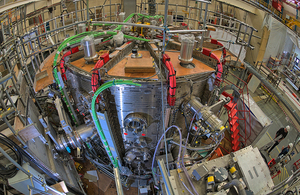First results from UK experiment point to a solution to one of fusion's hottest problems
Tests on the MAST Upgrade machine at Culham Science Centre are crucial for developing fusion power plants.

UKAEA's MAST Upgrade fusion experiment
-
UKAEA’s new MAST Upgrade device is solving a major challenge for commercial fusion energy
-
Tenfold reduction in heat on key fusion machine components
-
Boost for the UK’s ‘STEP’ programme to put fusion power on the grid for abundant, low-carbon electricity
Scientists at the UK Atomic Energy Authority (UKAEA) have successfully tested a world-first concept that could clear one of the major hurdles in developing fusion energy.
Initial results from UKAEA’s new ‘MAST Upgrade’ experiment at Culham, near Oxford, UK, have demonstrated the effectiveness of an innovative exhaust system designed to make compact fusion power plants commercially viable.
With no greenhouse gas emissions and abundant fuels, fusion can be a safe and sustainable part of the world’s future energy supply.
Fusion energy is based on the same principle by which stars create heat and light. Using a machine called a ‘tokamak,’ a fusion power station will heat a gas, or ‘plasma’, enabling types of hydrogen fuel to fuse together to release energy that can generate electricity.
A key challenge in getting tokamaks on the electricity grid is removing excess heat produced during fusion reactions.
Without an exhaust system that can handle this intense heat, materials will have to be regularly replaced – significantly affecting the amount of time a power plant could operate for.
The new system, known as a ‘Super-X divertor’, would allow components in future commercial tokamaks to last for much longer; greatly increasing the power plant’s availability, improving its economic viability and reducing the cost of fusion electricity. The concept for the Super-X divertor originally came from the Institute for Fusion Studies group at the University of Texas.
Tests at MAST Upgrade, which began operating in October 2020, have shown at least a tenfold reduction in the heat on materials with the Super-X system.
This is a game-changer for achieving fusion power plants that can deliver affordable, efficient electricity.
UKAEA is planning to build a prototype fusion power plant – known as STEP – by the early 2040s, using a compact machine called the ‘spherical tokamak’. The success of the Super-X divertor is a huge boost for engineers designing the STEP device, as it is particularly suited to the spherical tokamak.
The Super-X factor: UKAEA’s world-first fusion exhaust system
UKAEA is announcing the results at today’s official opening of the MAST Upgrade facility, where guest of honour, British astronaut Tim Peake, is creating his own artificial ‘star’ by running a plasma test on the machine.
MAST Upgrade is funded by the UK Government’s Department for Business, Energy & Industrial Strategy, the Engineering & Physical Sciences Research Council (EPSRC) and the EUROfusion consortium.
UKAEA’s Lead Scientist at MAST Upgrade, Dr Andrew Kirk, said:
These are fantastic results. They are the moment our team at UKAEA has been working towards for almost a decade.
We built MAST Upgrade to solve the exhaust problem for compact fusion power plants, and the signs are that we’ve succeeded.
Super-X reduces the heat on the exhaust system from a blowtorch level down to more like you’d find in a car engine. This could mean it would only have to be replaced once during the lifetime of a power plant.
It’s a pivotal development for the UK’s plan to put a fusion power plant on the grid by the early 2040s – and for bringing low-carbon energy from fusion to the world.
Science Minister Amanda Solloway said:
This is an incredible breakthrough for fusion energy in the UK. Just seven months since MAST Upgrade was powered up, it may already have found a solution to one of fusion’s greatest challenges.
Innovative projects like this one are crucial to cementing our status as a science superpower, and I am excited to see how it develops.
EPSRC Executive Chair, Professor Dame Lynn Gladden, said:
The UK has been a leader in the development of fusion energy for many years, strongly supported by EPSRC since the early 2000s. These first results from the MAST Upgrade project demonstrate that fusion as an energy source has the potential to radically change the world’s energy supply.
Updates to this page
-
Added a reference to the University of Texas and a link to their Super-X paper
-
First published.